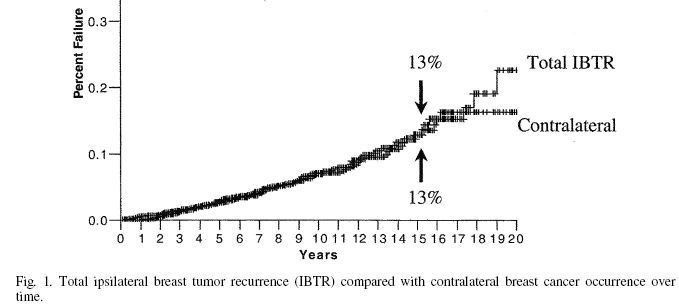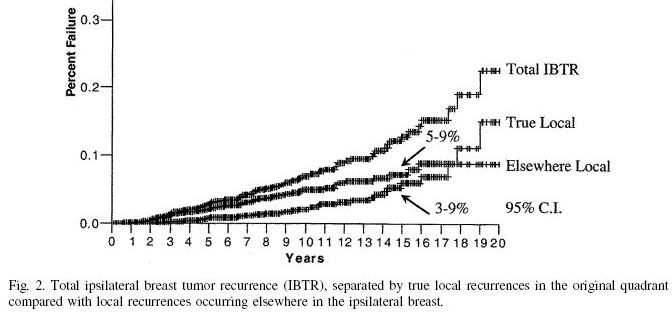Breast cancer recurrence rate
My studies on the epidemiology of breast cancer indicate that:
1. Many patients carry micrometastasis in good
health.
2. The longer a patient lives the better
her chances to survive.
The following study on tumor recurrence supports the notion that patients
carry hidden cancer for years and remain in good health.
Freedman et al. studied tumor recurrence after conservative surgery and whole
breast irradiation. (1).
They estimated long term risks of breast irradiation after breast conserving
surgery. The study population consisted of 1,990 women
with American Joint Committee on Cancer Stage 0, I, or II breast cancer treated
by breast-conserving surgery and radiation therapy between 1970 and 1998.
The median follow-up was 80 months (range, 1 to 245 months).There were 655
patients remaining at risk at 10 years and 135 patients at 15 years. The primary
endpoint of the study was ipsilateral breast tumor recurrence (IBTR);
this was subclassified as “true local” or confined to the original
quadrant as the initial primary tumor, or “elsewhere”
involving outside of the original tumor quadrant
The rate of any local recurrence for all patients was
3%, 7%, and 13% (95% confidence interval [CI], 10–16%) at 5, 10, and
15 years, respectively (Fig. 1). Recurrence
elsewhere in the breast was rare for the first 10 years, but by 15 years was
nearly equal to true local recurrence even after whole-breast irradiation.
The 15-year rate of elsewhere recurrence was half the rate of contralateral
breast cancers. The figures were copied from the original paper.


Interpretation
The recurrence rate in both breasts was the same (Fig. 1) indicating that
irradiation of the involved (ipsilateral) breast did not suppress nor increase
the recurrence rate. The true local recurrence was the same as the “elsewhere
local” (Fig.2). Thus from the beginning, the entire breast contained
tumor cells, and only part of them was removed by surgery. Even irradiation
did not kill them.
Since the recurrence rate in both breasts was the same (Fig. 1), either the
contralateral breast harbored cancer cells at the time of diagnosis, or the
tumor in the ipsilateral breast seeded metastasis soon after treatment.
In 13% of the patients tumor recurred after 15 years. Obviously not
all the tumor cells in the irradiated breast responded to the treatment.
These patients carried an undetected tumor for 15 years! What was their secret?
Elsewhere these patients who succeeded controlling their tumor for 15 years
are called cancer-yogis
This metaphor stands for the capability of the patient to live with
cancer in peace
References
1. GARY
M. FREEDMAN,
M.D., PENNY
R. ANDERSON,
M.D., ALEXANDRA
L. HANLON,
M.S., PH.D.,DEBRA
F. EISENBERG,
M.S., AND
NICOS
NICOLAOU,
M.D.
PATTERN
OF LOCAL RECURRENCE AFTER CONSERVATIVE SURGERYAND
WHOLE-BREAST IRRADIATION
Int. J. Radiation Oncology Biol. Phys., Vol. 61, No. 5, pp. 1328–1336,
2005